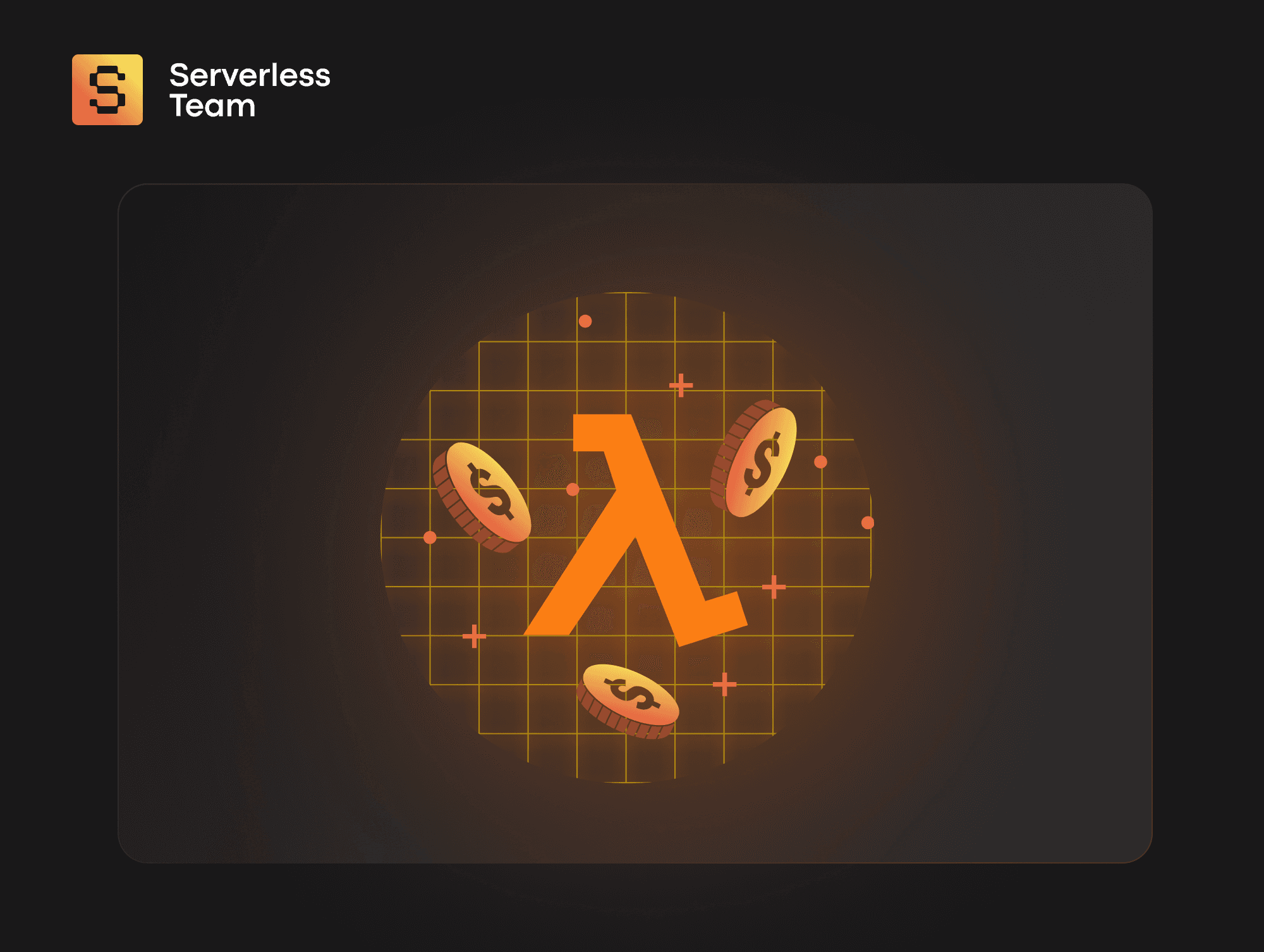This article covers what makes up the cost of running serverless applications on AWS Lambda and how to optimize it, focusing on AWS Lambda use cases that highlight its efficiency and cost-effectiveness.
AWS Lambda, Amazon's serverless computing service, offers a flexible and scalable solution for executing code without the hassle of managing servers. However, it's essential to grasp the aws lambda pricing model to manage expenses effectively when it comes to cost.
In this guide, we'll dive into the various components contributing to AWS Lambda costs, helping you gain insights into pricing per request, execution time impact, memory allocation charges, and additional considerations like data transfer and AWS service integration.
Let's explore how these factors influence the overall cost of running your Lambda functions and uncover strategies for optimizing your AWS Lambda expenses.

We take care of serverless development so you can focus on your business
Don't want to wait for our site launch? Let's talk about your idea right now.


Understanding AWS Lambda Pricing Model

Understanding the pricing of AWS Lambda is crucial for serverless applications for several reasons:
Cost Management: Serverless computing promises cost efficiency, but it's easy to overspend without a clear understanding of the pricing model. Knowing the cost components of AWS Lambda allows you to optimize your usage, avoiding unnecessary expenses and ensuring that your application stays within budget.
Budget Planning: By grasping Lambda's pricing structure, you can accurately forecast and plan your project's budget. This prevents unexpected cost spikes and ensures your serverless application remains financially sustainable throughout its lifecycle.
Scaling Strategies: AWS Lambda automatically scales with demand, but scaling can impact costs significantly. Understanding how pricing per request, execution time, and memory allocation influence expenses enables you to implement effective scaling strategies that balance performance with cost-effectiveness.
Resource Allocation: AWS Lambda allows you to configure memory allocation for functions. Knowing how memory affects pricing helps you strike the right balance between performance and cost, ensuring optimal resource allocation for your application.
Optimization Opportunities: With insights into the cost components, you can identify optimization opportunities in your serverless architecture. From refining code efficiency to minimizing data transfer costs, understanding the AWS Lambda pricing empowers you to make informed decisions for cost reduction.
Data Transfer Costs: Integrating Lambda with other AWS services or external APIs may incur data transfer fees. Being aware of these additional considerations allows you to evaluate the impact of data transfer on overall costs and optimize data usage.
It’s crucial to know the ins and outs of AWS Lambda function pricing to manage costs effectively, plan a budget, scale, allocate resources, and more. Armed with this knowledge, you can make well-informed decisions to ensure the success and cost-effectiveness of your serverless applications on AWS Lambda.

Kyrylo Kozak
CEO, Co-founderGet your project estimation!

Breakdown of the Components Contributing to AWS Lambda Costs
Let’s take a closer look at the components contributing to the costs of AWS Lambda:
- Pricing per Request: With AWS Lambda, you are billed for the number of requests made to your functions. This means you pay for one request every time your function is triggered, whether by an API call, an event, or any other method. AWS counts the total number of requests in a month and charges accordingly.
- Execution Time and its Impact on Cost: The execution time of your Lambda function is a crucial factor in determining costs. AWS Lambda bills you based on the time your function takes to execute, measured in milliseconds. The pricing is rounded up to the nearest 100 milliseconds. So, the longer your function runs, the more you'll be charged. It's essential to optimize your code and minimize execution time to keep costs under control.
- Pricing Based on Memory Allocation: When you create a Lambda function, you specify the amount of memory allocated to it, directly affecting how much aws lambda costs. You pay per 100 milliseconds of execution time and GB-second of memory usage. Meaning that the higher your memory allocation is, the pricier it gets ( despite bringing on faster execution times and better performance).
- Additional Cost Considerations:
- Data Transfer: If your Lambda function interacts with data stored outside the AWS region where it is running, you'll incur data transfer costs. Consider these charges, mainly if your function handles large amounts of data or communicates with resources in different regions.
- AWS Services Integration: AWS Lambda can easily integrate with other AWS services. However, remember that using these integrations comes with additional charges for the services you use. For example, if your Lambda function processes data stored in Amazon S3, you'll be billed for S3 data storage and data transfer.
- Free Tier Limit: AWS Lambda offers a free tier that includes a specific number of requests and compute time per month at no cost. The good thing is: you won't be charged as long as you stay within these limits. However, once you exceed the free tier limits, regular pricing will begin to apply.
Factors Affecting AWS Lambda Costs
When it comes to Lambda AWS pricing, understanding the factors that impact costs is essential for managing expenses effectively. As a serverless computing service, AWS Lambda offers a pay-as-you-go pricing model, billing users based on resource consumption. However, several factors can impact the final cost. Here are three key factors that play a crucial role in determining AWS Lambda costs:
Function Duration
AWS Lambda bills execution time in fine-grained increments of milliseconds. This means that even a slight increase in function duration noticeably impacts cost. To optimize costs, you should minimize the duration of the function by streamlining code execution and reducing unnecessary processing steps. Fine-tuning the function's logic and ensuring efficient resource utilization are the key to keeping your costs in check.
Choosing the Right Memory Settings
As already mentioned, memory allocation directly affects AWS Lambda's CPU power provisioned to execute functions. By selecting higher memory settings, the function gets more available memory and enjoys improved CPU performance. However, it's crucial to fine-tune memory usage to strike a balance between memory allocation and CPU performance to avoid unnecessary costs.
Request Volume
AWS Lambda charges users based on the number of requests processed, regardless of the function's execution time or memory allocation. Each invocation incurs a cost, making request volume a critical cost factor. Managing request volume involves optimizing the function's design and architecture to handle incoming traffic efficiently. Implementing caching mechanisms and minimizing redundant invocations can reduce the number of requests, resulting in cost savings.
Strategies for Optimizing AWS Lambda Costs

You should implement effective cost optimization strategies to get the most out of AWS Lambda while keeping costs under control. By following these strategies, you will be able to maximize the value of your serverless applications without overspending on cloud resources.
Make Your Lambda Functions Reasonable
Efficiency is the key to cost optimization in AWS Lambda. Designing "reasonable" functions means ensuring that each function performs its intended task without unnecessary overhead. Make sure to avoid complex and resource-intensive operations and optimize the function's execution flow, to reduce costs associated with excessive resource consumption significantly.
Use Effective Coding
Clean and optimized code plays a pivotal role in AWS Lambda cost management. Well-structured code leads to faster execution and reduces the amount of memory needed for each function invocation. You can minimize the time and resources required for function execution with efficient coding only. Cost reduction will follow.
Monitor App Usage
Keep an eye on the application usage and AWS Lambda functions to gain insights into resource consumption patterns. By understanding how resources are utilized, you can identify areas where optimization is needed.
Employ AWS Tools
Take advantage of the AWS monitoring tools mentioned in our article about the Top 10 AWS Cloud Cost Optimization Best Practices. These tools help teams proactively address inefficiencies and adjust resource allocation accordingly, ultimately reducing unnecessary costs.
AWS offers a suite of tools specifically designed for cost management. AWS Cost Explorer provides in-depth cost analysis, helping businesses identify cost drivers and trends. AWS Budgets allows teams to set custom cost and usage budgets, providing alerts when exceeding thresholds, and AWS Cost Anomaly Detection applies machine learning to detect unusual spending patterns and recommend potential optimizations.
By making these AWS tools a part of your arsenal, you will gain better visibility into your cloud spending, make data-driven decisions, and take proactive steps to optimize AWS Lambda costs effectively.
Predicting Serverless Application's Operating Cost
Calculating the operating cost of a serverless application is a crucial step in managing cloud expenses effectively. Understanding the key factors and resources that contribute to the overall cost allows businesses to optimize their serverless architecture while maintaining efficiency and scalability. So, how does one do this?
Step 1: Calculating Resources
To determine the operating cost of a serverless application, you must consider various factors, including the number of AWS Lambda function invocations, the execution time of each function, and the memory allocated to functions during execution. These fine-grained billing components significantly affect the overall cost, making it essential to optimize function duration and memory settings to reduce expenses.
Step 2: Assess the Amount of Needed Data Storage
Data storage is a critical aspect of serverless applications that directly affects cost. Try to calculate the amount of data stored and the type of storage used, such as Amazon S3 or DynamoDB. Understanding your data storage requirements allows you to choose the most cost-effective options while ensuring data accessibility and durability.
Step 3: Optimize Data Exchange
Data exchange between different AWS Lambda functions or services in a serverless architecture impacts the final costs. Each invocation and data transfer incurs a cost, so optimizing how data is exchanged and processed is essential for managing operating expenses. Employing best practices like minimizing data transfer and aggregating data before processing can help control costs.
By carefully evaluating resources, data storage, and data exchange patterns, you will surely gain a comprehensive understanding of your app’s operating cost. These insights will empower you to make informed decisions, optimize resource allocation, and ensure a cost-efficient and highly performant serverless environment.
And if you need help, our Serverless Team is here to navigate the complex world of Amazon aws lambda pricing with you.
Summary
Understanding AWS Lambda function pricing is crucial for serverless applications as it directly impacts overall costs. Factors like function duration, memory allocation, and request volume significantly influence expenses.
To optimize AWS Lambda costs, consider making functions efficient, employing effective coding practices, and monitoring application use. Utilizing AWS tools for cost management further enhances cost optimization. By carefully calculating resources, data storage, and data exchange, you will gain insights into what makes up the cost of operating your serverless app and learn to make informed decisions and maintain a cost-effective and high-performing environment.





